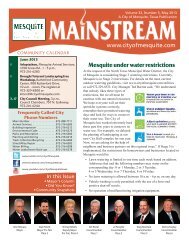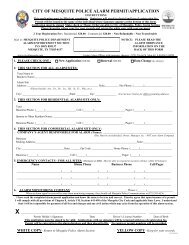airport/documents/Mesquite Master Plan Final.pdf - The City of ...
airport/documents/Mesquite Master Plan Final.pdf - The City of ...
airport/documents/Mesquite Master Plan Final.pdf - The City of ...
Create successful ePaper yourself
Turn your PDF publications into a flip-book with our unique Google optimized e-Paper software.
Haul Length<br />
<strong>The</strong> FAA Computer Program also<br />
provides an estimation <strong>of</strong> runway<br />
lengths for general aviation aircraft<br />
weighing more than 60,000 pounds.<br />
This group includes the Gulfstream<br />
family <strong>of</strong> aircraft and some new longrange<br />
corporate jets. <strong>The</strong> estimate <strong>of</strong><br />
runway length requirements for the<br />
large corporate aircraft over 60,000<br />
pounds considers all airfield data, but<br />
also considers the typical haul distance.<br />
<strong>The</strong> origin/destination <strong>of</strong> many aircraft<br />
utilizing the <strong>airport</strong> was previously<br />
identified in Table 3C. <strong>The</strong> larger<br />
Gulfstream jets had haul lengths <strong>of</strong><br />
nearly 1,400 miles, to destinations such<br />
as Palm Springs, California, and Palm<br />
Beach, Florida. Other destinations<br />
included St. Paul, MN (1,000 mi.),<br />
Jackson Hole, WY (1,400 mi.),<br />
Kissimmee, FL (1,100 mi.), and Black<br />
Hills, SD (1,100 mi.). Since it is known<br />
that, when conditions allow, business<br />
jet operators are opting for longer haul<br />
lengths, consideration will be given to<br />
accommodate aircraft weighing more<br />
than 60,000 pounds with haul lengths<br />
<strong>of</strong> 1,400 miles. As indicated in Table<br />
3G, aircraft weighing more than 60,000<br />
pounds, with haul lengths <strong>of</strong> 1,400<br />
miles, require a runway length <strong>of</strong> 6,900<br />
feet.<br />
Specific Aircraft Requirements<br />
An additional consideration for runway<br />
length is to analyze the runway length<br />
requirements <strong>of</strong> specific aircraft<br />
currently utilizing or planned to utilize<br />
<strong>Mesquite</strong> Metro Airport in the future.<br />
Table 3J presents the runway length<br />
3-17<br />
needs for a wide variety <strong>of</strong> business jets,<br />
as obtained from the operations<br />
manuals for each aircraft. Figures in<br />
the table consider maximum take-<strong>of</strong>f<br />
and landing weights. It should be noted<br />
that landing length requirements<br />
during contaminated runway conditions<br />
(rainy, with 1/10-inch <strong>of</strong> water on the<br />
runway) increase significantly for<br />
aircraft with single landing gear<br />
configurations due to hydroplaning<br />
potential.<br />
In general, the data specific to each<br />
airplane presented in Table 3J is<br />
similar to the generalized output by the<br />
FAA computer program (presented in<br />
Table 3G). Obviously, <strong>airport</strong> planning<br />
cannot always conform to the worst case<br />
(maximum load) scenario. <strong>Plan</strong>ning<br />
should at least conform to providing a<br />
runway length capable <strong>of</strong> accommodating<br />
the majority <strong>of</strong> aircraft, the<br />
majority <strong>of</strong> the year. In other words,<br />
the runway should be capable <strong>of</strong><br />
handling business jets with typical<br />
weight loading during moderate heat<br />
conditions.<br />
Several aircraft which currently utilize<br />
the <strong>airport</strong> on an infrequent basis can<br />
require runway lengths longer than<br />
6,000 feet. <strong>The</strong> Lear 55, Gulfstream IV<br />
and V, Hawker 800, and Challenger<br />
require up to 7,000 feet. <strong>The</strong>se aircraft<br />
are capable <strong>of</strong> operating at the <strong>airport</strong>,<br />
but are weight-restricted during hot<br />
weather days. Weight restrictions can<br />
include taking less fuel and making an<br />
additional stop along the intended<br />
route, boarding fewer passengers, or<br />
taking less cargo. During cooler days,<br />
the weight restrictions could be minor<br />
or may be unnecessary.




